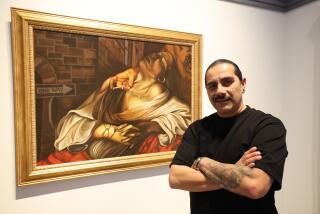Artist Chris Rush recounts life in the drug trade in ‘The Light Years’
Chris Rush was a Catholic kid, the middle child of seven in a brood headed by distracted, sometimes damaging parents. Their mother “regarded her children as her audience,” Rush writes, “and once we’d applauded, we could do as we wished.” Like his mother, Rush had a flair for the dramatic — setting up a life-size statue of the Virgin Mary in his basement bedroom, swanning around in a pink cape he found at a thrift store — that set him apart from the other boys. He loved art and the church, both of them serving the same purpose at times. “To me, drawing was as calming as prayer,” Rush writes.
This stunningly beautiful, original memoir is driven by a search for the divine, a quest that leads Rush into some dangerous places. Rush is now a successful artist, his work in many museums’ permanent collections, but as the book makes clear, it’s a kind of a miracle he survived his own childhood. At age 11, the summer before he’s to be sent away to boarding school because of his “alarming” intelligence test results (he’s too smart, it turns out), he meets his older sister Donna’s friend and dealer Valentine, a charismatic acolyte in the church of psychedelics. It’s the ’60s, and there’s an idealistic glow in the air, along with clouds of marijuana smoke. As Valentine tells Rush, “don’t call them drugs. Call them what they are — sacraments. Given to us by the Creator for our spiritual evolution.” As soon as he’s home from school the following summer, Rush begins to partake in the mood-altering communion. By age 13, he’s tripping on acid as often as he can and selling to his eager classmates.
“The Light Years” is funny and harrowing and deeply tender. As Rush recounts his adolescence, which becomes increasingly terrifying, it’s impossible not to worry about how badly things might turn out. Untethered from family and school, he spends months living with Donna, who has become a drug mule in Marin County. Brother and sister go thrift shopping to buy clothing that will mark her as a square, a young mother who couldn’t possibly have a suitcase full of LSD. As the ’60s turn into the ’70s, the business is booming, and drugs are big business — the dealer Donna carries for is becoming a multi-millionaire — but, as Rush notices, “the cash was always offstage.” At age 16, he writes, “I completely believed in the power of dope. While my brothers were in New Jersey eating candy and watching television … I was eating acid three or four times a week, watching my own visions.”
On pot and acid, I had always drawn fantasies, strange creatures in strange trees. But now, I wanted to draw what was in front of me.
— Chris Rush
It’s an Eden that can’t last. Rush moves with Donna to Arizona, then moves in with a friend’s family after his sister returns to New Jersey. Sexuality blooms, but it’s complicated — Rush falls for Owen, the friend whose house he’s welcomed into, but after a time, Owen’s Mormon family expels him. He is sent back to New Jersey, where the household’s sheen of middle-class perfection has gone blurry. His father is drinking too much, and his mother seems frantically unhappy. They sit in the den watching Walter Cronkite talk about the Vietnam War. “In Saigon, there are explosions,” Rush writes. “But here, in the house, the war proceeds in silence.” Before long, he’s on the move again.
The next few years unfold in a series of poor decisions and dangerous situations. There is a lot of hitchhiking and the kind of missed connections that seem crazy to us now in the age of smartphones. Rush takes drugs, sells drugs, reconnects with the big-time dealers he met through Donna. The sacramental, natural highs begin to give ground to more dangerous drugs. He nearly dies in a mysterious accident, and then again after a very bad cocaine experience. From “the grinning cherub, dosed at twelve,” Rush becomes a hollowed-out mess, a wandering loner, more or less homeless.
Although the book’s arc bends toward Rush’s eventual sobriety, this doesn’t read like a typical recovery memoir. His descriptions of his own drug use are unapologetic and even affectionate. And he never soft-pedals how difficult life becomes after he goes straight. “Without chemicals, I was unequipped to process everything that had happened,” Rush writes. “I’d been stoned for half my life. Since the age of twelve, drugs had been the only song playing in my head.”
In the end, “The Light Years” is both a coming-of-age book and an account of an artist’s development. In the clear light of the desert, at age 20, he takes up a pencil. “I sat before each blank piece of paper, as if before God.” He’s done with the surreal. “On pot and acid, I had always drawn fantasies, strange creatures in strange trees,” he writes. “But now I wanted to draw what was in front of me.” He sketches his own hands, then a rock, a boot, a box. “I took up again with the real.”
::
Chris Rush
Farrar, Straus and Giroux, 384 pp., $27
Tuttle is president of the National Book Critics Circle.
More to Read
Sign up for our Book Club newsletter
Get the latest news, events and more from the Los Angeles Times Book Club, and help us get L.A. reading and talking.
You may occasionally receive promotional content from the Los Angeles Times.






